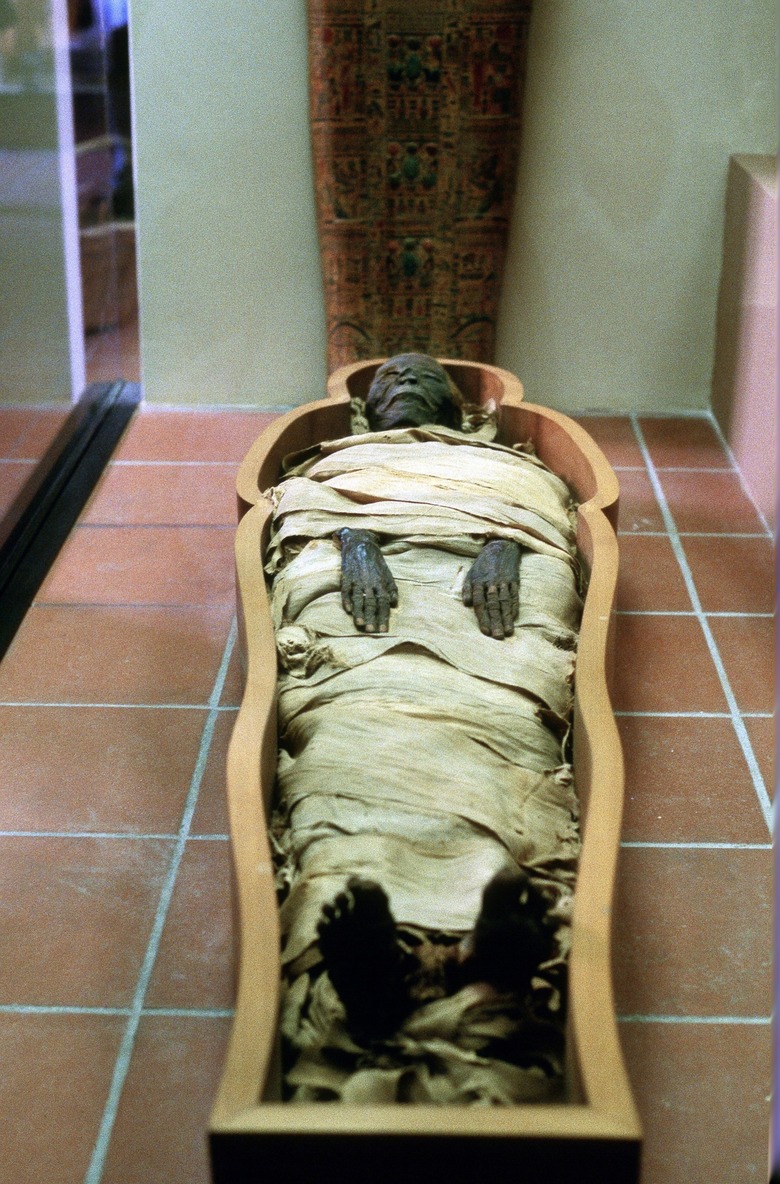In Ancient Egypt, What Did They Put In A Mummy's Stomach?
Burial in ancient Egypt was all about preserving the body. They believed the body had to last after death in order for the soul to re-enter it and use it in the afterlife. Originally, bodies were wrapped and buried in the sand. The dry, sandy conditions naturally preserved the bodies. When Egyptians started burying their dead in tombs, another method of preserving the bodies was needed since the bodies decayed. To combat this decay, they developed the mummification process.
What Was the Embalming Process?
What Was the Embalming Process?
Mummification was a 70-day process that involved religious aspects as well as practical embalming tasks. For the wealthy and royal Egyptians, the mummification was completed by priests. After washing and purifying the body, the priests removed the organs. They dried the body, washed it with aromatic oils and wrapped the body in strips of linen. The organ-removal process differed for the middle class, and the poor who could not afford proper embalming were merely rinsed out with solvent and left to cure for 70 days.
Why Did They Remove the Organs?
Why Did They Remove the Organs?
The brain, lungs, liver, stomach and intestines were removed during the embalming process. The embalmers left the heart in the body because they believed the person's intellect and knowledge resided in the heart so it needed to remain with the body. The other organs were removed because they would cause the body to decay if left in place. As much water as possible was removed to help prevent decay. The organs not only held lots of water, they also contained bacteria and other substances like bile or partially digested food that would hasten decay.
Drying the Body
Drying the Body
After the organs were removed, either through an incision on the side of the abdomen for the wealthiest clients, or by injecting oil or a solvent into the body cavity and letting it liquify the organs so they could be drained, the body was dried. Embalmers placed packets of natron, a dessicating natural salt found in dry lake and river beds, into the body cavity to absorb moisture. The natron was left in the body for 40 days, by which time the cavity was dry. The bodies of both wealthy and middle-class clients were covered with natron as well, though middle-class clients with no incisions did not get the internal packets.
Mummification -- 2600 B.C. Through the New Kingdom Era
Mummification — 2600 B.C. Through the New Kingdom Era
For much of ancient Egyptian history, in the mummification process the organs removed from the body were dried with natron, wrapped in linen and placed in individual jars, called canopic jars. Except for the brain, which was thrown out as it was not considered important. The drying process performed on the body, as well as the lack of internal organs, made the body cavity appear sunken. To give it a more natural appearance, linens and other dry materials such as leaves or sawdust were placed in the cavity to fill it out. Linen packets of spices might also be placed in the cavity. Middle-class clients who did not have the organs removed through an incision did not receive such filling.
Later Mummification -- Later New Kingdom Era and Beyond
Later Mummification — Later New Kingdom Era and Beyond
Mummification was practiced for over 2,000 years, and in this time a few adjustments were made. One of these was the cessation of storing organs in canopic jars. Instead, the dried organs were returned to the body cavity, though empty canopic jars were still placed in the tomb. The preservation process was the same; organs were removed and dried in natron. The dried organs were wrapped in linen. Then the linen-wrapped organs were returned to the body cavity. Additional linen and other dry materials were packed in with the organs if necessary to fill the cavity space.
Cite This Article
MLA
Kokemuller, Jill. "In Ancient Egypt, What Did They Put In A Mummy's Stomach?" sciencing.com, https://www.sciencing.com/ancient-egypt-did-put-mummys-stomach-10309/. 24 April 2017.
APA
Kokemuller, Jill. (2017, April 24). In Ancient Egypt, What Did They Put In A Mummy's Stomach?. sciencing.com. Retrieved from https://www.sciencing.com/ancient-egypt-did-put-mummys-stomach-10309/
Chicago
Kokemuller, Jill. In Ancient Egypt, What Did They Put In A Mummy's Stomach? last modified March 24, 2022. https://www.sciencing.com/ancient-egypt-did-put-mummys-stomach-10309/
